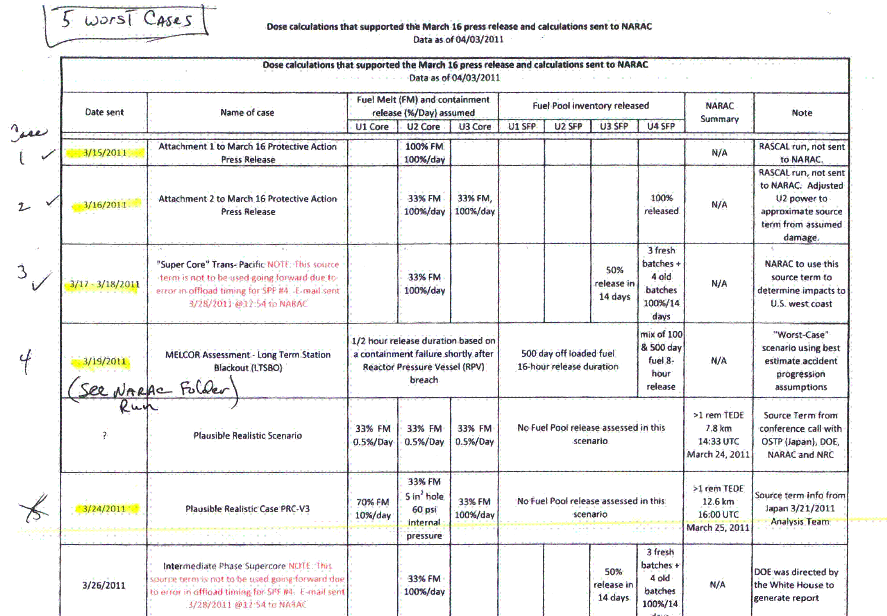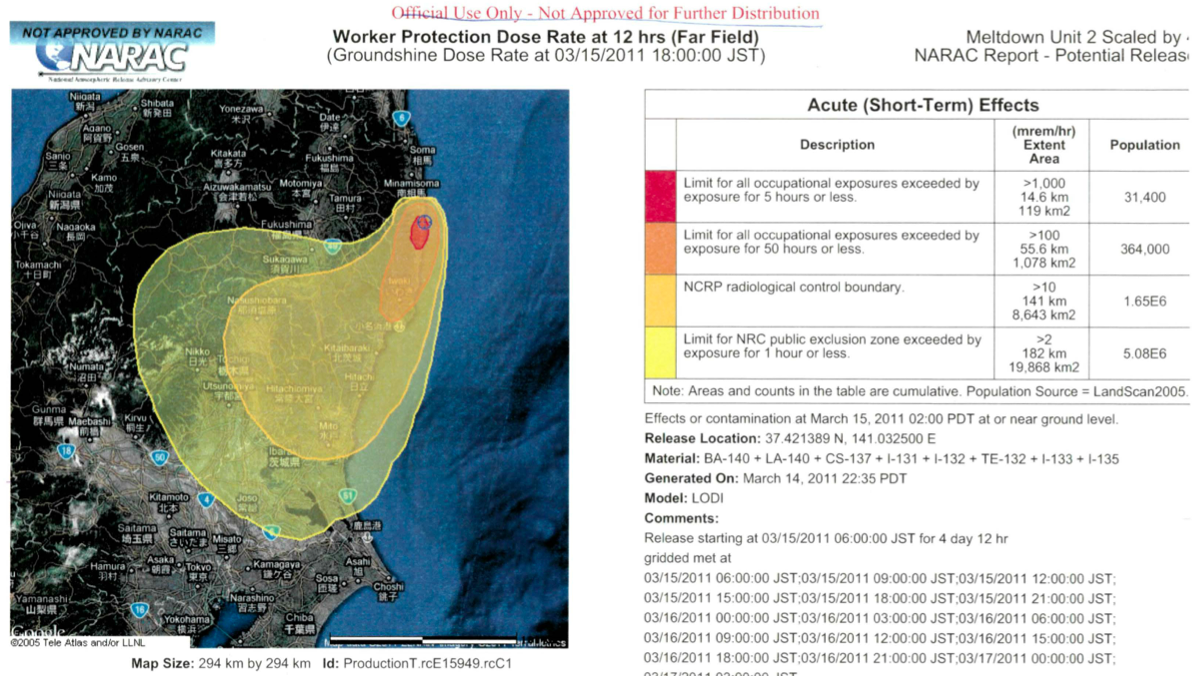USNRC disclosed Fukushima disaster worst cases simulations to FOIA request. According to the 40 pages document, NRC executive team’s chronological proceedings)revealed in 2012, NRC had drafted 5 worst scenarios,. However, their modeling code named RASCAL( Radiological Assessment System for Consequence AnaLysis ) , had very limited calculation ability, lacking for the modeling capability to foreshadow the disperse of radioactivity more than 50 miles extent.
To compensate their computer system’s performance, NRC sent NARAC ( the National Atmospheric Release Advisory Capability ) the expected radioactivity release data, quantity and timing of nuclear material disperse from the Fukushima Daiichi site. And NARAC sent back the NRC to the calculation result of expected radioactivity contamination map pictured by its superior computer code LODI ( Lagrangian Operational Dispersion Integrator ) atmospheric dispersion modeling system. This co-work of 2 U.S. agencies started since March 15, 2011.
The actual radioactive source term they used to develop the simulation had not been known except for a few versions attached in the NRC press Release, however. It was a long belonging question. Though AP has reported the expected radioactive exposure to Alaska may above 5rem for children based on released vague terms in e-mails, no detailed dose rate map had been disclosed before. And because of the lack of data, public debate on extent of possible nuclear facility hazards somewhat blocked to proceed.
In response to further FOIA request, February 2014, NRC at last revealed radioactive source term information including 5 worst cases expecting melt out of fuel from reactors in Unit 1 to 3 and SPF( Spent Fuel Pool ) in Unit 1 to Unit 4, in Fukushima Daiichi Nuclear Power Plant.
 ( Please click here to the 10 pages pdf files )
( Please click here to the 10 pages pdf files )
Also, expected Contamination Zone Map given that source term and the measures recommended as accordance with U.S. authority’s Early Phase PAG ( Protective Action Guideline ) is disclosed in March, 2014.Although In the document, however, only the release from reactor 2 was assumed ( one of the 5 worst scenarios NRC configured ) the result is catastrophic and the administration of PAG was quiet unrealistic.
First, Thyroid Radioactivity Dose, in proportionate of which the thyroid cancer is considered to develop were and needed to be KI ( Potassium Iodide ) goes as map and tables below. The record expected the disperse of radioactivity plume from the Fukushima Daiichi to the Tokyo metropolitan population density area and as far as 217 km from the site, children under 18 years old are recommended to use KI to prevent the absorb of radioactive Iodide isotope. This protective measure was unrealistic because the complete shortage of KI stock piles ( though still the accurate numbers unknown ) at the time and difficulty of logistics to distribute the drug just after the seismic event struck transportation network.
Next, Groundshine Dose Rate for the workers and public is drawn below. Here, limit for public exclusion zone, its threshold is set as 0.02mSV per hour, goes 172 km to the south west under the meteorological condition at the time. Again, the realistic protective measure is desperately impossible. How can all the ordinary people in Japan’s biggest urban ( perhaps one of the world most developed ) area ) can effectively evacuate? And taking account that all the recovery work in the early stage after the earthquake and logistics should be done ( and actually done) by normal persons to keep on manage the Fukushima Daiichi, some could not be replaced. As easily expected, panic inevitably expected to accompany would make the situation much worse. In spite of those difficulties, no effective action plan was prepared to beyond the ‘’nuclear safety myth ’’ at all.

( Click here for the PDF files )
Although the document disclaimer says these simulation not directly lead to countermeasure for the disaster, the reality is that we had no counter measure. T’he author want to use the word ’Luckily’’, to explain the development of events in which complete loss of the water in any Fukushima Daiichi Nuclear Power plant Unit had not occurred, ( on the contrary to the U.S. and Japanese experts pessimistic speculations ) . Japanese authority’s( JNRA ) current PAG is based upon query optimistic basis;; Radioactivity release from the nuclear power plant is equivalent to the Fukushima Daiichi at most. According to it residents only around 30 km radius extent from the site are expected to exposed to the dosage necessary to use KI pills. Japan’s ‘’nuclear safety myth’’ had not washed up by disastrous Tsunami in March 11 2011.
Takanori Eto
まだデータがありません。